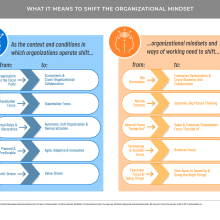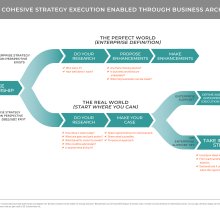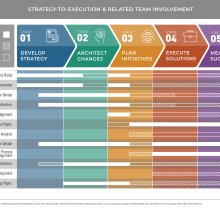This marks the 50th installment of StraightTalk, and we’re returning to our roots. Waaay back in Post No. 3, we introduced a new vision for strategy execution and explored how business architecture could help to enable it. We called it the Strategy Execution Metanoia, because a metanoia is a transformational moment – when you see the world in a different way and can’t go back.
What if our organizations could shift:
From what’s best for the silos…To what’s best for the enterprise with collaboration across business units
From narrow focuses for initiatives and issue resolution…To systemic, big picture thinking
From internal focus (“inside out”)…To value and customer/stakeholder focus (“outside in”)
From technology and solution focus…To business focus
From execution focus and doing things…To slowing down to speed up and doing the right things
From fragmented, unintentional strategy execution…To deliberately designed, transparent and owned strategy execution from end-to-end
See below for a summary of these important shifts.
Great strategy execution (i.e., the ability to translate direction into action quickly and well) can be a source of competitive advantage for an organization, though one could argue that it will soon just become necessary for survival considering the increasing magnitude and speed of change. And it takes a village. Great strategy execution takes an ecosystem of teams working together in harmony to move big ideas into action. Business architecture plays its own important (and often missing) role but is also instrumental as a dot connector and enabler of other teams as well.
The recognition of business architecture’s role in strategy execution has continued to gain traction among organizations, communities of practitioners, industry associations (like the Business Architecture Guild®), vendors, and even the academic community to some extent. So now what? What can business architecture teams do to actually make it real within their organizations? StraightTalk No. 50 can help.
P.S. Before reading this post, make sure to check out StraightTalk Post No. 3: The Strategy Execution Metanoia (a.k.a. Translating Strategy Into Action With Business Architecture) and some of the resources in More Good Stuff to gain background and context for the role of business architecture in strategy execution.
Where do we start?
The first thing you can do is ensure the right positioning for the business architecture team within your organization. Regardless of where the team actually reports or how it is structured, make sure that business architecture is understood to be a strategic, business-focused, enterprise discipline placed after strategy but before planning and initiatives. (BTW, you can check out No. 8, for more information on business architecture team structures.)
As the business architecture discipline gains traction, there is an encouraging trend in that more and more new business architecture teams are positioned just as they should be from the very beginning.
Our team is not ideally positioned. Now what?
You’re not alone. If your business architecture team is not positioned ideally – perhaps because it is more focused downstream on initiatives or perhaps because people in the organization view you through a technology lens — remember that you can always adjust. Start by reshaping your value proposition in a way that is aligned with the strategic intent of the discipline and make sure that you are well-prepared to deliver on it.
It may not happen overnight and it may not be easy, but business architecture teams have overcome this challenge many times. In fact, it is commonly referred to as shifting left, which means moving the role of business architecture upstream in the strategy execution life cycle over time.
Got it. What next to make it real?
First, you have to have a vision — a new vision for strategy execution with business architecture. This, of course, requires a pre-requisite understanding of business architecture, how strategy execution should work and how it currently works in your organization.
Before you can influence others and start working to make it real, you have to see it and believe it. (See No. 3 and other resources for some inspiration. Make sure to talk to your business architecture friends who have been on this journey, too.)
Check. Next?
Here’s where you take ownership for the good of the organization and start mobilizing and influencing others. Below are a couple of common paths for creating cohesive strategy execution, which is enabled by business architecture.
- The Perfect Path (Enterprise Definition): This is when your organization already has a cohesive enterprise perspective and process in place for end-to-end strategy execution with cross-business unit coordination, transparency and ownership. In this case, the business architecture team can focus on integrating business architecture into the appropriate steps (e.g. to inform and translate strategy, to frame initiatives and requirements, and to measure results back to business objectives) and sharing any additional ideas for improvement.
- The Real World (Start Where You Can): This is when your organization has fragmented (and likely ineffective) strategy execution activities that occur in various silos, portfolios, processes and teams. In this case, the business architecture team has some more work to do because it’s not just about integrating business architecture into the appropriate places, but also working with others to help the organization reimage and reshape how strategy execution works. If there is enough support for these ideas at an enterprise level, then progress can be made. Otherwise, you can simply take interim steps. Introduce ideas to others when you can. Form partnerships and just start working differently among yourselves. Take advantage of opportunities to work end-to-end across the strategy execution life cycle when they present themselves (e.g. to translate one strategy starting from the beginning).
Check out the handy diagram here for more on these two paths.
Who should we work with?
Business architecture teams should work closely with a wide variety of teams, such as those related to strategy, innovation, customer experience design, portfolio management, planning at various levels, organizational change management, business process, organizational effectiveness and business analysis – to name just a few.
It is critically important for business architecture teams to:
- Identify all related teams.
- Document those teams in an Engagement Model.
- Understand where each team plays across the strategy execution life cycle.
- Define the value provided and interactions between each team.
- Deliberately build integration and strong partnerships with each team over time.
Good partnerships are everything and are what will actually make a new vision for strategy execution real. Check out the diagram below for a perspective on how a subset of teams work together across strategy execution.
(Check out No. 5 for more about business architecture and how to build partnerships with other teams.)
How have other organizations done this?
At a high level, pretty much like it is described here. There’s no silver bullet. It’s a journey and it requires the hard work of formulating and sharing a vision for better strategy execution, partnering with other like-minded people, and working the change from within the organization day after day.
However, when it comes to people who truly care about an organization, its customers and stakeholders, and its mission – never doubt what a small and mighty group of them can do. Dream big and do big.
More Good Stuff…
The Strategy Execution Metanoia: A New Approach for Translating Strategy Into Action with Business Architecture (S2E white paper): A foundational whitepaper that explores how business architecture can be leveraged as a means to integrated business direction that is collectively architected, prioritized and planned from a business-driven, enterprise-wide perspective.
Leveraging Business Architecture to Translate Strategy Into Action (S2E diagram): A second take on the diagram above, but with more to the story. This one was created based on an original 12 by 8 foot hand-drawn masterpiece by Sarah Greer.
Leveraging Business Architecture: Translate Strategy Into Action (Cutter Webinar): An on-demand webinar (available to anyone) which explores an enterprise perspective on the strategy execution life cycle and the critical role business architecture plays throughout.
Business Architecture Integration (S2E white paper): A white paper on how business architecture interacts with other teams and how to formally integrate with them.
Business Architecture Interaction With Related Teams (S2E diagram): A diagram which describes the value of business architecture for a common set of related teams.
Business Architecture — The Gateway to Transforming an Organization into an Agile Enterprise (White paper by Whynde Kuehn and William Ulrich): An overview of how business architecture enables end-to-end organizational agility through effective, coordinated translation of business directives into targeted results from strategy formulation through strategy realization. Case study included.
Business Architecture and Strategy Realization (BIZBOK® Guide by Business Architecture Guild®): Check out Section 3.11 in the BIZBOK® Guide for content on business architecture and strategy realization. (Membership required.) There is also reference to the role of business architecture in strategy realization in Part 1 of the BIZBOK® Guide. (No membership required.)
94 Mind-Blowing Strategy Execution Stats (Boardview): A gold mine of statistics on strategy execution all in one place. While a bit concerning, they are helpful when you’re making a case for business architecture.
Why Strategy Execution Unravels—and What to Do About It (HBR): A video which articulates the five myths of strategy. Business architecture can help with every single one.
Execution Is a People Problem, Not a Strategy Problem (Harvard Business Review): “Your organization’s biggest strategic challenge isn’t strategic thinking — it’s strategic acting.” Another perspective on the importance of outcome clarity and behavioral clarity for strategy execution.
The Fifth Discipline: The Art and Practice of the Learning Organization (Book by Peter Senge): If you haven’t read this classic, add it to your list. It really is an incredible piece and reflects many common themes such as the mind shift from seeing parts to seeing wholes, the importance of system thinking, and the power of shared visions. Senge even introduces the concept of metanoia as “a fundamental movement or shift in mind” which requires “deep shifts in our orientation.”
Draw Your Future (TED Talks): An outstanding TED Talk by Patti Dobrowolski on drawing your dreams into reality. A must watch.



